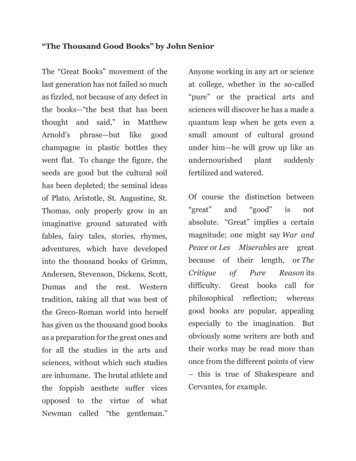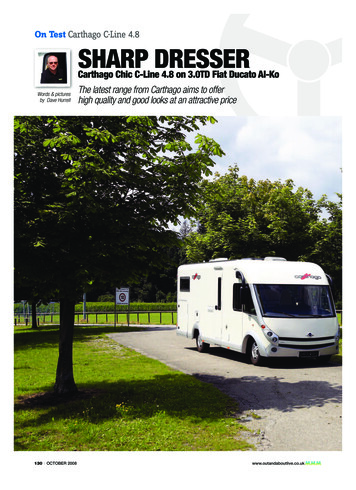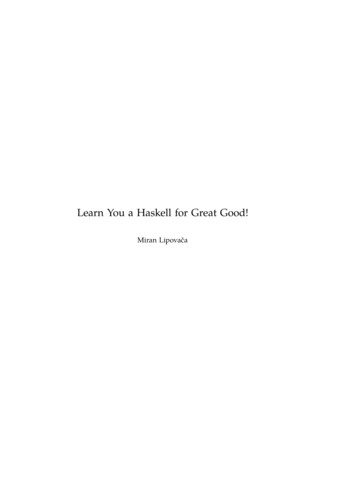
Transcription
WHY BUSINESS THINKINGIS NOT THE ANSWERGOO D TO GREATANO THESOC IAL SECTORSA Monograph to AccompanyGood 10 GrealWhy Some CompaniesMake t he Leap . . .and Others Don'tJIM COLLINS, L e7
0 200 5 by Ji m coum s. All R1chts ReservedNOTTO BE REPRODUCED\'lIth ool Express Permi sSIOn from Jim CollinsISBN·13: 978-0-9773264-0-2ISBN·lO,O-9773264 -0-3
AUTHOR'S NOTEDurin g m y first yea r o n th e Stan fo rd fac ult y in 1988, 1 so ugh t ou tProfessor John Gard ne r fo r guidance on how I m ight becom e a bett erteach e r. Ga rd ne r, fo rme r Secreta ry o f Health, Ed ucatio n a nd Welfare,fou nder of Co m mon Cause, a nd autho r of th e classic text Self- liel/ell'al,stu ng me with a co m me n t that changed m y life." It occurs to me. Jim. that you spend too mu ch time tryi ng to beinteresting," he said. "Why do n't you invest mo re time being interested."I don't know if th is mo nogra ph will prove interesting to everyon ewho read s it, but I do kno w that it result s fro m my growing int erest inthe social sector s. My interest began for two reasons. First is the surprising reach of o ur work into the social sectors. I'm generally categorizedas a business aut hor. yet a third or more of my readers com e from no nbusiness. Seco nd is the sheer joy of learn ing some thing new- in thiscase , ab out th e challenges facin g socia l secto r leader s- a nd pu zzlingover qu estion s that arise from applying o ur wo rk to circu mstances quited iffer en t fro m business.I ori ginally int ended this text to be a new cha p ter in futur e ed itionso f Gaad to Great. But upo n reflectio n , I co ncl uded th at it wo uld beinapp ro pri ate to force my read ers to bu y a seco nd copy o f the boo k justto get access to th is piece-and so we decided to crea te th is indep end entm on ograph. That said, while this monograph can certainly be read as astand -alo ne piece, I've written it to go hand-i n-han d with the boo k, andth e greatest value will accrue to thos e who read the two togethe r.I do not co nsider myself an expert on the soc ial sectors, but in thesp irit o f John Gard ner, I am a student. Yet I' ve becom e a passionatestudent. I've come to see tha t it is simply not good eno ugh to focus solelyo n havi ng a great bu sin ess secto r. If we o nly have great companies, wewill merely have a prospero us society. no t a great o ne. Econo mic growthan d power a rc the means, not th e definitio n. of a grea t nat io n.Jim Coll inswww.jimcol lins. comBoulder. ColoradoJury 24. 2005
GOOD TO GREATAND THE SOCIA L SECTORSWhy Busi ness Thin king Is Not the Answe rWe m ust reject the idea- well-i ntentio ned, but dead wro ng-tha t th eprimary path to greatness in the soc ial sectors is to becom e "morelike a bu siness." Mos t bu sinesses-like m ost of anyth ing else in lifefall somewhere be twee n medi ocre and good. Few are great. W hen)'OUcompare great companies with good ones, many widely practicedbusiness norm s turn ou t to cor relate w ith med iocrity. no t greatness.So . then . why wo uld we want to impo rt the p ractices o f medioc rityint o the social sec to rs?I shared this per sp ective with a gathe ring of busin ess CEO s, an doffend ed nea rly everyon e in the room . A h an d sho t up fro m DavidWeekley, o ne o f the more tho ug htfu l C EOs- a m an who bu ilt a verysuccessful comp,lO y and who now spends nearl y half his time worki ngw ith the soc ial sec to rs. "Do yo u have evide nce to suppo rt your poi nt?"he deman ded . " In m y work with no n p ro fits, I find t ha t th ey' re indesperate need of greater discipline-disciplined planning, disciplinedpeople, d isciplined govern anc e, d iscip lioed alloca tion of reso urces.""Wha t makes yo u th ink tha t's a business co ncept?" I repli ed. " Mostbusinesses also have a desperate need for greater discipline. Mediocreco m pan ies rarely d isplay the relen tless cu ltur e o f di scip line-disc ip lin ed peo pl e who e ngage in d isc ip li ned thou ght a nd wh o tak edisciplined action- that we find in truly great companies. A culture ofdiscipline is not a principle of business; it is a principle of greatness."Later, at d inner, we co n tinued our deba te, a nd I asked Weekley: " Ifyou had taken a diffe ren t pa th in life and beco m e, say, a chur ch leader,
2JI M COLLINSa un iversity p resident , a nonp rofit leader, a hospital CEO, o r a schoo lsuper intenden t. wo uld yo u have bee n any less discip lined in yo ura pproac h? Wou ld yo u have been less likely to p rac tice en ligh te nedleadersh ip, nr put less ene rgy into getting the right people o n the bu s, o rbeen less dema nd ing of results?" Weekley conside red the questio n for alo ng mo ment. "No, I suspect no t:'That's when it dawned on me: we need a new language. The criticaldistinction is not between business and social, but between grea tand good. We need to reject the naive imposition of the "languageof business" on the social sectors, and instead jointly embrace alanguage of greatness.T hat's what o ur work is abo u t: bu ild ing a fra mework of grea tness,artic ulating timeless pr inc iples that explain why some become great a ndo thers do not. \Ve derived these principles from a rigo rous matched pair research method , co mparing companie s that beca me great wi thcom panies that did not. O ur work is not funda men tally abou t business;it is abo ut what separates great from good .THE GOOD-TO -GREAT MATCHED-PAIR RESEA RCH METHODInflecti on PointWhal principles explain thedifference?Good. not Great. . . . . . . . . . . . . . . . . . . . . . . . . . . . . . . . . . . . . . . . . . . . . . . . . . . . . . . . . . . . . . . . . . . . .Good, not GreatComparison CasesMatch ed-Pair Selection(Comparable cases at the moment ofinflection)
GOOD TO GREAT AND THE SOCIAL SECTORS3Social sector leaders have emb raced this distinction-the principlesof greatness, as distinct from the practices of business-with remarkable case. If a nonbusiness reader is just as likely to email me as abusiness reader, thcn somewhere between 30% and 50% of those whohave read Good to Great co me fro m no nb usiness. We've receivedtho usands of calls, letters, emails and invitatio ns fro m ed ucatio n.hcalthcare, churches, the arts, social services, cause-driven no nprofits,police, government agencies, and even military units.Two messages leap out, First, the good-to-great principles do indeedapply to the social sectors, perhaps even better than we expected. Second ,par ticular questions crop up repeatedly from social sector leaders facingrealities they perceive to be q uite differen t fro m the bu siness secto r. I' vesynthesized these questions into five issues that form the framework o fth is piece:I - Defining "Great"-Calibrating Success without Business Metrics2 - Level 5 Leader ship-Gett ing Th ings Do ne within a DiffusePower Structure3 - First Wh o- Getting the Right People o n the Ilus withinSocial Sector Co nstraints4 - Th e Hedgeho g Concept- Rethinking the Eco no mic Enginewithout a Profit Motive5 - Turn ing the Flywheel - Ilu ild ing Momen tum by Ilu ildin gthe Bran dI've based this piece on critical feedback, structured interviews, andlabo rato ry wo rk with more than 100 soci al sector leaders. While I hop eto eventually see the results of matched -pair research that uses nonbusiness entities as the data set, such research studies- clone rightrequire up to a decade to complete. In the mea n time , I feel a responsi-bility to respo nd to the quest ions raised by those who seek to apply thegood-to-great p rinciples today, and I offer th is monograph as a sma llinterim step.
4JI M COLLINSI SSUE ONE, DEFINI NG " GREAT" - CALI BRATI NG SUCCESS WITHOUTBUSI NESS METRI CSIn 1995, officers at the New York City Police Department (N YPD) foundan ano nymo us note posted on the bu lletin boa rd. "'Vc'rc not rep orttakers," the not e proclaimed. "We' re the po lice.'" Th e not e testified to thepsychological shift when then Police Com missioner William ). Brattoninverted the focus from inputs to outputs. Prio r to Bratto n, the NYPDassessed itself primarily o n input variables- such as arrests made. report s taken. cases clo sed , bu dge ts met - rather than o n the outputvariable of reduci ng cri me . Bratton set audacio us output goals,such as attaining double-dig it annual decl ines in felon y crime rates,and impl ement ed a cata lytic mechani sm called Co mpstat (sho rt for"co mputer co mparison statistics").A 1996 Time article describes a polic e captain sweating at a pod iumin the command center. He stands before an overhead map with a bunchof.red dot s. showing a significant increase in robberies in his precinct.In a Socratic grilling session reminiscent o f Professor Kingfield in ThePu per Chase, the questio ns come relentlessly. "What is the pattern here?""What arc you go ing to do to take these guys o ut!'? Acco rding to CIGIllsight magazine, 75% of commanders fou nd them selves ejected fromthei r po sitio ns for failing to redu ce crime in their precincts. "If, weekafter week at the Compstat meetings, we found precinct comma ndersnot perform ing to the standards," explained Bratto n, "we had to findsomeone else to do the job .'"Thi s di stin ct ion betw een inp uts and outputs is fun damenta l, yetfrequently m issed . I recen tly opened the pages of a busi ness magazinethat rated charities based in part o n the percentage o f budget spent o nmanagement , overhead and fund raising. It's a well-intent ion ed idea, butreflects profound confusion between inputs and outputs. Thin k about itthis way: If you rank collegiate ath letic de pa rtm ent s based on coachingsalari es, you'd find tha t Stanford University has a higher coaching coststruc ture as a percentage of to tal expenses than so me ot her DivisionI schools. Should we therefore rank Stanfo rd as "less great"? Following thelogic of the business magazine, that's what we might conclude- and our
GOOD TO GREAT AND THE SOCIAL SECTORS5concl usion would be absurd. Stanfo rd won th e Nation al Association ofCollegiaIe Directo rs of Ath letics Cup for best overall perfor mance for lOconsecutive years, beating out all other majo r schools, while deliveringat hlete gradu ation rates above 80%.4 To say. "Stanford is a less greatpro gram becau se it has a hig her salary structure than some o therschools" wou ld m iss the main point th at SIanford Athleti cs deliveredexceptional performan ce, defined by the bottom-line outputs of athleticand acade mic achievement.The confusion between in puts and outp uts stems from one of thepri mary differences between business and the social sectors. Inbusiness, money is bot h an input (a resource for achieving greatness)and an outp ut (a measure of greatness). In the social sectors, moneyis only an in put , and not a measure of great ness.A great o rganization is one that delivers superio r performance andmakes 1 distinctive impact over a long period of time. For a business.financial returns arc a perfectly legitimate measure of per formance. Fora social secto r o rganizatio n, however, perfor mance m ust be assessedrelative to mission, not financial returns . In the social sectors, the criticalquestion is not "How muc h mo ney do we make per dollar of investedcapital?" bUI "How effectively do we deliver on o ur mission and makea distinctive impa ct, relative to our resources?"Now, you might be thin king, "O K, but collegiate spo rts programsand po lice departments have one giant advantage: youCi1l1measurewin records and crime rates. Wh at if your o utputs are inh erently notme asurable?" T he basic idea is st ill th e same : separa te inputs fromoutp ut s, and hold yo urself acco untable fo r pro gress in o utputs,Cl'e llif those outp uts riefy meas urement.Wh en Tom Mo rris became executive direc to r of Th e ClevelandOr chestra in 1987, the orchestra faced deficits exceeding 10%, a smallan d stag nan t endowm ent, and a strugglin g loca l eco no my. Prio r totaking th e po sition , Morr is asked two key board members, "Wh at dorO llwant me to do if I come here?" Th eir ans wer: make an alreadygreat o rchest ra even greater, defined by ar tistic excellence.
6JIM COLLINSGR EATNESS AT THE CLE VELAND ORCHE STRA Emotio nal response of audience; number of standingovatio ns increased.- Wide technical range: can play any piece wit h excelle nce,no matter how diffi cult-from soothing and famil iar ctassrcal pieces to diff icult and unfamili ar modern pieces.SUPERIORPERFORMANCE Increased demand for ttck ets-c-even for more comp lex,imaginative programs-not ju st in Cleveland, but alsowhen visit ing New York and Europe. Invited (and then retnvit ed, and relnvit ed again) toSalzburg Festi val -for the first t ime in 2 5 years-signifying elite status with th e top European orchestras.- The Cleveland style of programm ing increasingly copiedand becoming more influ enti al.- A key point of civic pride; cab drivers say, " We're reallyproud of our orchestra."OISTINC TlVEI MPACT- Severance Hall fil led to capaci ty two nights all er gI l l, asa place for the commu nity to grieve together through thetrenstormetive power of great music.- Orchestra leaders increasingly sought for leadership rolesand perspect ives in eli te ind ustry groups/gatherings.- Excelle nce sustai ned across generati ons of ccnductor s-cfrom George Szell t hrough Pierre Boulez, Christoph vonDctmanyt, and Franz Weiser-MOst.LASTINGENDU RANCE Supporters donate time and money, investing in t he longterm success of t he orchestra; endowment tri pled.- Strong organization belore, during and after TomMorris's tenure.To m Mor ris co uld no t precisely measure artistic excellence, bu t thatdocs not change the fact that artistic excellence is the primary definitionof performanc e fo r T he Cleveland Orches tra. No r d ocs it cha nge th eext re me d isci pline with which Th e Cleveland Orchestra held itselfacco unt ab le for playing th e m ost cha llenging classical mu sic w ithsupre me artistic excellence, and do ing so even bett er with each passing
GOOD TO GREAT AND THE SOCIAL SECTORS7yea r, guided by the BHAG (Big Hairy Audac io us Goal) of beco m ingrecognized as o ne of the three greatest orchest ras in the wo rld."We asked a simple question ," explained Morris. "What do we meanby great results?"Morris and his team tracked a variety of indicators. Arewe getting more standing ovatio ns?Are we expanding the range of whatwe can play with perfectio n-from clean classical pieces to co mplexmodern pieces? Are we invited to the most prestigious festivals inEurope? Are tickets in greater dem and, no t just in Cleveland , but whenwe play in New York? Do people increasingly mimic the Clevelandstyle of programming? Do composers in creasing ly seck to have theirwo rk debuted at Cleveland? Under Tom Mo rri s, the orchestra tripledits endowment to 120 m illion (eve n accounting for the post-dotcornbubble decline in assets ) an d funded a remodel of Severa nce Hall int oone of the best mu sic halls anywhere. He accomplished this because heunderstood that endowme nt, revenues and cost structure were inputvariables, no t the output variables of great ness.'Clear, rigo rou s th in kin g is precisely wha t C levela nd's Tom Mo rr isand New York's Co m m issio ne r Bratton bro ught to the ir wo rk. Theysepa ra ted in pu ts fro m o ut p u ts, a nd had the d iscip line to hol d theiro rganizations account able for achievement in the outputs. That Brattonhad the adva ntage of quantitative metrics, and Mo rris did not , is largelybesid e the po int.It doesn't really matter whether you can quantify your results. Whatmatters is that yo u rigorously assemble evidence-Quantitative orqualitative-to track your progress. If the evidence is primarilyqualitative, think like a trial lawyer assembli ng the combined bodyof evidence. If the evidence is primarily quantitative, then think ofyourself as a laboratory scientist assembling and assessing the data.To throw our hands up and say, "But we cannot measure performance in the social sectors the way yo u can in a busin ess" is simplylac k o f di scipline. All indica tors ar e flawed , whethe r qu alitat ive or
8J IM CO LLINSqua nt itative. Test scores are flawed , mamm ograms are fl awed, cr imed ata are flawed , cus tomer service data are flawed, pat ient -o ut com eda ta arc flawed. What mailers is no t find ing the perfect indica tor, butsett ling upo n a consistent and intelligent m eth od o f assessing you routput results, and then trac king yo ur traject or y with rigor. Wha t doyou mea n by grea t performance? Have you established a baseline? Areyou im proving? If no t, why not? How ca n yo u improve even fastertoward your audaci ous goals?GOOD-TO- GREAT FRAMEWORK-tNPUTS AND OUTPUTS OF GREATNESSINPUTS or GREATNESSBY APPLYING THEGO OD·TO·GREAT FRAMEWO RKSTAGE I,DISCIPLINEDPlD PIE- Level 5 Leadership First Who, Then WhalOUTPUTS or GREATNESSYOU BUILD THEFOUNDATIONS OFA GRE AT ORGANIZATIONO(lI VE RS SUP RIOR P RfORMA NCEIn business, perform ance i sdefi ned by li nancia l ret urns andachievement 01 corpora tepurpose. I n the social sec tors ,performance is defi ned by resultsenc etticlen cy in deli vering on theSTAGE 2,soc ial m ission.DISCiPliNED THDUD ln- Confront th e Brut al FactsMAKE S A DISTINC TIVE IMPACT The HedgchOIl ConceptThe organizat ion makes such auniq ue contribution to th ecomm unities it touches and doesi ts work wit h such unadu lteratedmet ifSTAGE J:excell enceDISCIPLINED ACTlONappear, il would leave a hole that c utturc 01 Discipli necould not be easily l ill ed by any The Flywheelother tnst uunon on the planet .It were to dis -ACHIE VES l UTIN G ENPURA NCEThe organi zation can deli verSTAGE4 ,excepti onal rescns over a longBUil DING GREATNESS TO LASTper iod 01 l ime, beyond any single Clock Bu ild ing,not n me Tellingor well -fund ed program. When- Preserve the Core ISti mul ate PrDgres.sleader, greet idea, market cycle,hi t Wit h setbacks , i t bouncesback even slronger than before .You can think o f the entire good-to-grea t framewor k as a genericset o f input vari ables that correlate strongly with creat ing the ou tp utsof grea tness. (In the d iagram "Go od -to -Great Fra mework- In p uts
GOOD TO GREIIT liND THE SOClll l SECTORS9and O utpu ts o f Greatnes s" on page 8, I've su m marized the idea ,showi ng how disciplined appl icat ion o f th e good -to -great princip lesleads to creating the outputs that define a great o rganizatio n.) Anyjo urney from good to great requir es relentl essly ad her ing to theseinpu t variables, rigoro usly tracking your trajecto ry on the output vari-ables, and then dr iving your self to even higher levels of performanceand impact. No matter how muc h you have achieved, yOll will alwaysbe merely good relative to what you call becomc. Greatness is an inheren tly dyn ami c process, no t an end poi nt. Th e mome nt you thi nk ofyours elf as great, your slid e toward me d iocrity will have already begun .I SSUE TWO , LEVEL S LEADERSHtP-GETTI NG THt NGS DONE WITHIN ADtFFUSE POWER STRUCTUREWhen Frances Hesselbein becam e CEO o f the Girl Scouts o f the USA,a New York Tintcs columnist asked what it felt like to be o n top of sucha large o rganization. With patience, like a teacher pausing to impart animportant lesson , Hcssclbein proceeded to rearrange the lunch table,c reating a set of co ncen tric circles radiatin g o utward- plates, cup s,saucers- co nnected by knives, forks and spoo ns. Hessclb ein point edto a glass in the middle of the table. "I'm here," she said." I-lesselbeinmay have had the title of Chief Executive Officer, but her message wasclear: 1'1111101 Oiltop of allYthing.Facing a complex governance structure co mpo sed of hundred s o flocal Girl Scou t cou ncils (each with its own govern ing bo ard ) and avo lu nt eer force of 650,000, I-lesselbein sim ply d id not have the fu llpower o f decision . Even so, she moved peopl e to confront brutal factsfacing girls in modern America, such as teen pregnancy and alcohol use,by creatin g materials on se nsi tive issues. Proficie ncy badges sproutedup in top ics like math , technology an d co mpu ter science, to reinforcethe idea that girls are-and sho uld think o f the mselves as-s-capableind ividu als who can take con trol o f their own lives. Hesselbe in didnot force this change dow n peop le's th roats, bu t simply gave the interdepe nd ent counci ls the opport unity to mak e ch an ges at the ir ow nd iscre tio n. Most did .'
10JIM COLLINSWhen asked how she got all this don e without concentrated executivepower, she said, "Oh, you always have power, if you just know where tofind it. There is the power o f inclu sion, and the po wer o f language, andthe power of shared interests, and the power of coalition. Power is allaroun d you to draw upo n, but it is rarely raw, rarely visible." Whetherthey answer to a nonp rofit board com posed of pro minent cit izens, anelected school board, a govern men tal oversight mechanism, a set oftrustees, a democratic religious congregat ion, an elected membershipassociation or any number of other species of governan ce, social sectorleaders face a complex and diffuse power map. When you add in tenure dfaculty, civil service, volunteers, police union s, or any nu mber of otherin ternal fact ors, mo st non b usi ness lead er s simply do no t ha ve theconcen trated decision power of a business CEO.Social secto r leaders are not less decisive tha n busine ss leaders asa general rule; they only appear that way to those who fail to graspth e comp lex govern ance and diffuse power str uct ures common tosocial sectors. Frances Hesselbein was just as decisive as nearly anycorporate CEO, but she faced a governance and power structure tha trend ered executive-style leadership impracti cal.Thi s is why some busines s execu tives fail when they move intoth e social secto rs. One co rpo rate CEO tu rned acade m ic dean tri edto lead faculty toward his vision. The mor e he brough t to bear hisexecuti ve skill, the more th e facult y decided they had better things todo than to atte nd the dean's facult y meetings. After all, wha t was hego ing to do? Fire them ? Th ey all had ten ure. After "o ne of the mostdra ining experiences in my life," thi s CEO ret urn ed to th e busin essworld. He did no t unde rsta nd-u nt il it was too late- what oneun iversity president called the reality of tenu red faculty: "A tho usandpoint s of no."The comp lex govern ance and diffuse power structures commonin nonbus iness lead me to hypot hesize that there arc two type s of
GOOD TO GREAT AN D TH E SOCIAL SECTORS11lead ersh ip skill: exeel/I;ve and legislative. In executive leader ship, theindividu al leader has eno ugh concentrated power to simp ly make therigh t decision s. In legislative leadership , on the o ther hand , no individu alleader-s-no t even the nomi nal chief executive- has enoug h struc tur alpower to make th e most impo rt an t d ecision s by him self or herself.Legislative leadershi p relies more upon persuasion, politica l cu rrency,and shared in terests to create the con di tio ns for the right decisio ns tohappen. And it is pre cisely th is legislative dynamic tha t ma kes Level Sleadersh ip part icularly im port an t to the social sectors.Our good -to -great research uncovered that leadersh ip ca pabilitiesfollow a five-level hierarchy, with Level S at the top. Level S leaders d ifferfrom Level 4 leaders in tha t they are amb itio us first and foremost forthe cau se, the movement, the mission, the work-not tlzcmsdl'cs-andthey have the will to do whatever it takes iwlmtcvcr it takes) to makegood o n that ambit ion. (See dia gram: " Level S Leadersh ip" on page 12.)In the social sectors, the Level 5's compelling combination of personalhu m ility an d profession al will is a key factor in creating legitimacyand in fluence. After all, why sho uld th ose over who m yo u have nod irect po wer give them selves over to a decisio n th at is primarily abo utyou? As o ne soci al secto r leader co nfided, " I' ve learn ed tha t LevelSleadersh ip requ ires bein g clever for the greater goo d. In the end, it ismy respo nsib ility to ens ure th at the right decision s happen- even if Idon 't have the sale power to make those decis ions , and even if thosede cisio ns could not win a pop ular vo te. The o nly way I can ac hieveth at is if peo pl e know th at I'm moti vat ed firs t and always fo r th egreatness of our wor k, not myself."Level 5 leadership is not about being " soft" or " nice" or purely "incl usive" or " consensus-building." The whole point of Level 5 is to makesure the right decisions happen-no matter how diff icult or painfulfor the long-term greatness of the institution and the achievement ofits mission, independent of consensus or popularity.
12JIM COLLINSLEVEL 5 LEA DERS HIP I L EVEL 5 H IERARCH YLEVEL 5LEva 5 EXECUTIVEBuilds enduringgreatnessthrough aparaci(l ical blend ofpersonal humility andprofessional will.LEVEL 4EffECTM lEADERLEVEL lCatalyzes commitment to and vigCl'oUSpursuit of a clear and compelling visiOfl,stlmulatlng higher performance stimdalds.lEVEL 2Orgilnil es pear le and re!oDu rces toward the ettecnve andefficient pursuit of peedetermmec objK ti'ltlS.COM PETENT MANAGERCOHTRIBUTlhGTEAM "'EMBERConlributes individual capabilities to the itChll!'lement of groupobjl!Cll es, .lid works ellectlrely '/Iltn othen in oil iJOllp I h ng.HIGHLYCAPABLE IrtDlVlllUAlMilkes productive contributions through tatent, knowltldge,skills, and !lood workhabits.The executive versus legislative distinction remains a working hypothesis, awaiting rigorous research. If empirical evidence validates thedistinct ion, it is unlikely to be as simple as "business sector executive"and "social sectors legislative." More likely, there will be a spect ru m,and th e mo st effective leaders will show a blend of bet]: execut ive andlegislativ e skills. The best leaders of the future-in th e soci al secto rsand business-will not be purely executive or legislative: they will havea knack for knowing when to play their execut ive chips, and when no t to.There is an irony in all this. Social sector organizations increasinglyloo k to business for lead ership model s and talent, yet I suspect we willfind more true leadership in the social sectors than the business sector.How can I say that? Because, as James MacGregor Burns taught in hisclassic 1978 text, Leadership, the practice of leadersh ip is not th e sameas the exercise of po wer.' lf I put a load ed gun to your head, I can getyou to do things yo u m igh t no t othe rwise do, bu t I've no t practi ced
GOOD TO GREAT AND THE SOCIAL SECTORSleadershi p; I've exercised power. Tw e leadership0111)' exists13if people[ollow when the)' hnvc the freedom 1I0t to. If peop le follow you becausethey have no choice, then yo u are not leadin g. Today's bu siness leadersface h ighl y m obile kn ow ledge wo rkers. T hey face Sarba nes-Oxley,enviro nmental and co nsume r groups, and shareho lder activists. Inshor t, business executives don 't have the same conce ntration of pureexecutive power th ey o nce enjoyed . Level 5 leadership combined withlegislative skill will become even more important to the next generationof bu siness execut ives, and they would do well to learn from the socialsecto rs. Indeed, perhaps tomorrow 's great business leaders will comefrom the social secto rs, not the othe r way around.IS SUE TH REE , FIRST WHO- GETTING THE RIGHT PEOPLE ON THE BUS ,WITHtN SOCIAL SECTOR CONSTRAtNT SIn t976, 25-year-old Roger Briggs began teaching physics at a subur banpublic high school in Boulder, Co lo rado. As he settled into daily teaching. a persistent thought pushed to the front of his conscio usness, likea pebb le inside a shoe: Our schools couk! be so II l1lch better.But what could he do? He wasn't principal. He wasn't superi ntendent.He wasn't governor. Roger Briggs wanted to remain on the front line ofedu cation, sho ulder to shoulder with fellow teachers. After beco mingdepart ment chair, Briggs decided to turn his little arena int o a pocketo f greatness. "I rejected the idea of being just a member of the 'wo rkerclass,' accepti ng goo d as goo d eno ug h. I co uld n't change the wholesystem, bu t I could change our 14-person science departm en t: 'He began the same way all the good-to-great leaders began: First getthe right people o n the bus. Given the low compe nsation for teachersand the paucity of incent ives, Briggs had to fill faculty seats with peoplecompu lsively driven to make whatever they touch the best it can be-notbecause of what they would "get" fo r it, but because they simply couldnot stop themse lves from the almost neurotic need to improve. With ateacher s' unio n that protected the mediocre and excellent alike, Briggs
14JIM COLLINSknew it wou ld be more difficult to get the wrong people off the bus, sohe focused instead on getting the right people all the bu s. He began toview the first three years of a teacher's career as an extended inte rview.He inverted the three-year tenure reco m mendation from a defau lt of"Yes, you'll likely get tenure, unless you've done something egregiou s"to a default of "No, you will most likely nat get tenure, unless you haveproven yourself to be an exceptional teacher:'A turning point came when an adequate teacher came up for tenure."He was a good teacher, but not a great one:' explained Briggs. "And I justfelt we could n't accept merely 'good ' for our depa rtm ent." Briggs arguedagainst granting tenu re, and held firm to his co untercultural position.Soo n thereafter, a spectacular young teacher becam e available, and thescience department hired her. "Had we tenured the other teacher, we'dhave a good person in that seat, whe reas now we have a great teacher,"explain ed Briggs. As the culture of disciplin e tightened, the wrong teachers found themselves to be vi
have read Good to Great come from nonbusiness. We 've received thousands of calls, letters, emails and invitations from education. hcalthcare, churches, the arts, social services, cause-driven nonprofits, police, government agencies, and even military units. Two messages leap out, Firs










